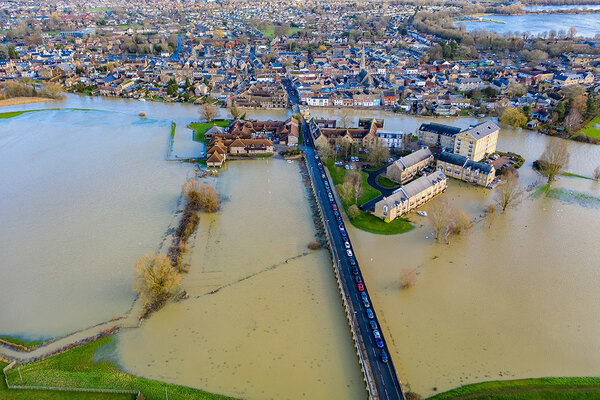You are viewing 1 of your 1 free articles

Don’t forget the growing problem of flood risk
Flood risk is still a problem – and it is likely to get worse. Homes in disadvantaged areas will be even more at risk, warns Victoria Brayshaw
Around one in six properties in the UK is currently at risk of flooding. The impact is heart-breaking. The floods of 2015/16 and 2019/20 give real perspective to what ‘flood risk’ truly means.
At the beginning of December 2015, Storm Desmond brought record rainfall and flooding to Cumbria. This was swiftly followed by Storm Eva, which brought flooding to Leeds, Manchester and York. Then, as a final blow, Storm Frank struck Scotland and parts of England, leaving more homes flooded.
At the time, these floods were described as the most extreme on record by the Centre for Ecology & Hydrology and cost the economy some £1.6bn. Flooding at any time of year is devastating, and those affected are unlikely to ever forget Christmas 2015.
More recently, in 2019 a summer and autumn of heavy rainfall led to saturated soils and vulnerable catchments, bringing severe flooding to parts of Northern England in November, and culminating in the dual arrival of Storm Ciara and Dennis in the early months of 2020.
It is clear that flood threat in the UK is showing little sign of abating.
Re-pledging our commitment to flood resilience
The floods of 2019/20 led to loss of life and cost the economy about £375m. Though it’s possible to become desensitised to the tragedy behind the numbers – especially against the backdrop of a global pandemic – the physical and emotional cost of flooding remains all too real.
“Families in disadvantaged areas will be disproportionately impacted”
While the government’s gaze was firmly focused on mapping a route out of lockdown and towards economic recovery, the threats of climate change have not gone away. The planet has continued to warm, with the Met Office Hadley Centre’s climate change projections showing an increased chance of warmer, wetter winters and hotter, drier summers, as well as an increase in the frequency and intensity of extreme weather events.
The impact of this on homes has not gone unnoticed. A recent study from the Grantham Research Institute found that that 5% of homes built in the decade between 2008 and 2018 are currently considered to be at high risk of flooding. Without further action, this will increase to 7% under a 2C warming scenario, or 14% under a high-end warming scenario. For disadvantaged areas, the figures are even more worrying, standing at 9% and 21% respectively.
This is a tragic double blow, as we can expect not only an increase in the frequency of extreme events, such as the floods of 2015/16 and 2019/20, but also an increase in the number of homes at risk. Families in disadvantaged areas will be disproportionately impacted.
Changing tides
To tackle this, the government in Westminster recently committed to doubling investment in the Flood and Coastal Defence Programme in England to £5.2bn. The funds will be used to enhance flood protection to around 336,000 properties by 2027, as well as provide support to help households recover more quickly after flooding.
Significantly, the plan also includes changes to the joint government and insurance industry ‘Flood Re’ scheme. Subject to consultation, this will allow claims to include an additional amount so that flood resilience measures are included in repairs.
On top of this, earlier this year the Environment Agency and Department for Environment, Food and Rural Affairs also committed £150m to innovative flood defence projects, including projects based on artificial intelligence, sensors and flood alert apps. This funding is part of the Flood and Coastal Resilience Innovation Programme.
“Flood risk and climate change must remain at the forefront of decision-making in the planning, design and construction of new homes”
Through these measures, the government and agencies have demonstrated a firm commitment to tackling flood risk. This is certainly a positive thing. However, key to the success of these cash injections will be the government’s ability to deploy these funds strategically.
Adopting the right approach
As home to some of the world’s foremost climate scientists, to truly capitalise on funding boosts, it is vital that the sector works collaboratively with the Met Office Hadley Centre to ensure a co-ordinated response to growing flood threats.
In short, it is primarily by engaging with their research that the industry will be able to develop a deeper understanding of the specific changes we are facing. We’ve already seen progress in this area, as UK flood risk professionals continue to harness climate projections to ensure that designs for residential developments account for extreme storms and the impact of climate change.
But to do this, we cannot rely upon data sets and ‘sparkly’ new technologies alone. Flood risk and climate change must remain at the forefront of decision-making in the planning, design and construction of new homes, with the sector maintaining a vulnerability and risk-based approach, as is rightly enshrined in planning policy.
We must not forget that the consequence of ‘pushing the boundaries’ in this area comes at great human and economic cost.
After all, if we are ever to achieve the dual challenge of limiting climate change while meeting the government’s ambition to build 300,000 new homes a year, building homes in the right places will be key.
Victoria Brayshaw, head of development and residential, Tetra Tech











